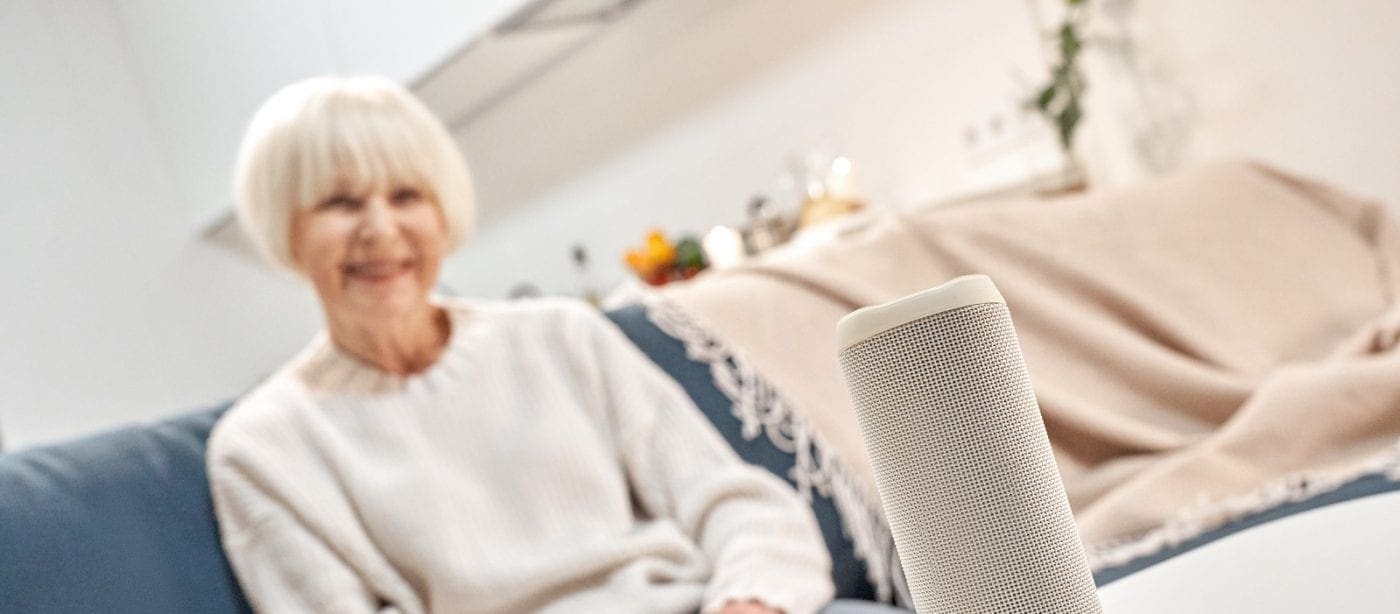As technology progresses at an exponential rate, every successive generation of digital products becomes more intuitive and applicable to everyday life. With each iteration, technology makes everyday tasks easier to accomplish for everyone.
One piece of technology that’s caught on especially well is the use of voice control for seniors. For senior living communities, voice control adoption through the use of a smart device or other device represents a bold new way to make resident’s lives that much easier and safer.
What are Voice Control Devices and Common Uses?
Voice control is a touchless technology solution. Everyday commercial uses include Siri on your iPhone or Amazon Alexa in your home. How it works is simple: you speak a voice command into a phone or a speaker and the Automated Intelligence (AI) device then performs the desired action. Or, you ask the smart device a question and it will then respond with an answer.
For instance, if you wanted to dim your smart lights, you’d simply say “[Alexa or Siri] turn off my Hue lights.” The voice control AI would hear it’s name called, process the request, and then turn off the lights, all without you ever having to leave the comfort of your couch.
The Growing Use and Need for Residents
Naturally, voice control for seniors lends itself to a wide range of applications for seniors who might already have mobility issues or who simply want an easier way to accomplish daily tasks. A simple voice command can significantly improve senior care for seniors.
According to Argentum:
“In the realm of senior care, experts see a range of potential uses for voice assistants. Those with dexterity issues or vision impairment can benefit from the voice interface. It’s easier to speak a request than to dial a phone or read a printed schedule. The technology can also work in support of memory care.”
Voice communication is our easiest and most natural way of interacting with others. Most people would prefer to talk rather than type, text, or click. For seniors, this makes the technology seem familiar and intuitive from the outset. It’s a simpler way to get things done, especially for residents with visual or physical impairments.
Additionally, this type of voice technology can respond to a variety of requests, including:
- Providing news or weather updates
- Managing appointments in the calendar
- Setting reminders
- Ordering meals
- Asking general questions
- Controlling the room or tv settings
Because it is so easy to use, seniors are actually some of the most enthusiastic adopters of voice technologies, with the vast majority of them preferring it to text. Per McKnight’s Senior Living, this supposition is backed by several different surveys:
- AARP’s “2019 Tech and the 50+ Survey” found that adoption in adults aged 50 or more years almost doubled in one year, from 7% in 2017 to 13% in 2018.
- In January 2019, Voicebot.ai reported that 20.1% of adults aged 60 or more years own a smart speaker and of those, 46.6% are daily users.
- The Pew Research Center reported as early as 2017 that 37% of U.S. voice assistant users were aged 50 or more years.
These numbers combined with a wealth of anecdotal evidence point to the fact that older generations are far more comfortable and likely to utilize voice control technology than they are with practically any other type of digital tool.
The Benefits of Voice Technology in Senior Living
There are several exciting reasons why senior living community providers should look to voice control technology to help them improve resident health and happiness. Apart from being unobtrusive technology, and aiding residents with limited mobility, voice technology offers the following immediate benefits:
- Accomplish tasks without additional risk – Residents who are at a fall risk can accomplish tasks without having to get up from their seat – such as turning on/off lights or adjusting the temperature.
- Increases staff efficiency – Residents should be encouraged to interact with staff and caregivers. That said, voice controls can help reduce the number of simple informational queries, like “What’s the weather going to be like?” or “What’s on the dining menu?” that can consume too much of a staff’s valuable time. Additionally, this technology helps staff work more efficiently since they don’t have to focus the majority of their day responding to simple resident requests.
- Staves off isolation – Especially in an era of social distancing and isolation, residents need all the interaction they can get. And, as this type of technology progresses, it will only get better at understanding resident preferences and providing accurate responses and meaningful communication.
What to Look for In Voice Control Technology
The frontier of senior living is the widespread adoption of voice technology. Primarily because it can make their life easier.
Right now, it’s an early-stage differentiator. But, going forward—with tech-savvy Baby Boomers soon to make the transition into senior living—this type of technological integration can give senior living communities a significant competitive edge.
Many commercial voice products have limited functionality. Alexa, Siri, and Cortana are only able to control smart technologies that have built-in integrations. Otherwise, they won’t work.
While these have a wide set of use cases, they aren’t made for senior living communities. They don’t naturally integrate with the legacy systems already in place, but rather, are limited to their specific products (i.e. iPhone, Amazon Echo) and some third-party applications.
So, when you’re looking for voice control technology, you need voice recognition software that’s programmed specifically for senior living communities. These days, Amazon Lex is the ideal platform to build your community’s voice control system on.
Lex is a cloud-based automatic speech recognition (ASR) and natural language understanding service. It can be used with other cloud services to build out smart assistants designed for a specific task or purpose. The virtual assistant software enables programs to understand human language, offering more dynamic ways of interacting.
Benefits of this type of smart home technology software include:
- Easy to use and build out natural language models
- Democratized deep learning technologies
- Seamless deployment and scaling
- Cost-effective
The Sentrics Way
To fully unlock the capabilities of voice control, you need a technology partner with deep roots in senior living and an understanding of what residents need and want, rather than generic voice technology built into consumer products.
This brings us to Sentrics and the Engage360 platform, which is built on Lex and comes with sentrics-built voice controls. Unlike other applications that require the residents to purchase Alexa or another voice control system, Engage360 has its own voice control and does not require any additional hardware to use.
At the end of the day, voice control is the future. And Sentrics has harnessed this smart technology to empower residents.
Sources :
- Argentum. Integrating Voice-Activated Technology in Senior Living. https://www.argentum.org/magazine-articles/integrating-voice-activated-technology-in-senior-living/
- CDC. Important Facts on Falls.
https://www.cdc.gov/falls/data-research/ - McKnight’s Senior Living. 3 ways voice-first technology can help older adults in the era of social distancing. https://www.mcknightsseniorliving.com/home/columns/marketplace-columns/3-ways-voice-first-technology-can-help-older-adults-in-the-era-of-social-distancing/



